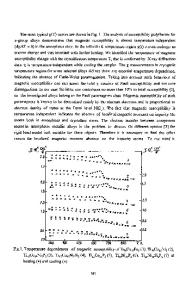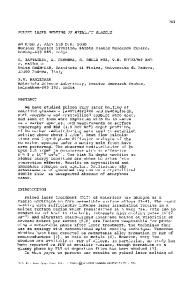Stability of the Pd-Co-Ni-Cu-P Metallic Glasses
- PDF / 736,434 Bytes
- 7 Pages / 612 x 792 pts (letter) Page_size
- 51 Downloads / 332 Views
1048-Z05-21
Stability of the Pd-Co-Ni-Cu-P Metallic Glasses Daisuke Fukamaki1, Tsunehiro Takeuchi1,2, Masashi Hasegawa3, Kazuo Soda4, Hirokazu Sato5, and Uichiro Mizutani6 1 Department of Applied Physics, Nagoya University, Nagoya, 464-0843, Japan 2 Eco Topia Science Institute, Nagoya University, Nagoya, 464-8601, Japan 3 Department of Materials Science and Engineering, Nagoya University, Nagoya, 464-8601, Japan 4 Department of Quantum Mechanics Engineering, Nagoya University, Nagoya, 464-8601, Japan 5 Department of Physics, Aichi University of Education, Kariya, 448-8542, Japan 6 Toyota Physical and Chemical Research Institute, Nagakute, 480-1192, Japan ABSTRACT Stability of Pd-Co-Ni-Cu-P metallic glass was investigated in terms of free energy using first principle cluster calculations, thermal analysis, and photoemission spectroscopy measurements. We found that the internal energy of the Pd-based metallic glasses is dominated by the electronic structure near the Fermi level. The analyses on the electronic structure and local atomic arrangements indicate that the substitution of cobalt or a hypothetical atom Co0.5Cu0.5 for nickel in the Pd40Ni40P20 metallic glass decreases the free energy of the Pd-Ni-P metallic glass by increasing entropy without altering significantly internal energy. On the basis of the idea mentioned above, we prepared Pd28Co24Ni24P24, Pd25Co25Ni25P25 and Pd40Co40/3Ni40/3Cu40/3P20 metallic glasses. These metallic glasses certainly showed the nearly highest TX, which reflect the activation energy against crystallization, among the Pd-based metallic glasses ever reported. INTRODUCTION Bulk metallic glasses (BMG’s) have attracted attention as a new material possessing highly useful mechanical properties such as high mechanical strength, high corrosion resistance, good shaping ability, and soft-magnetic properties [1]. In order to design the BMG’s best suited for each practical usage, it is of great importance to clarify their stability from microscopic point of view; local atomic arrangements and electronic structure. One may naturally expect that the BMG’s would have a very low free-energy, which is determined by internal-energy and entropy. For typical metals, the internal-energy is dominantly reduced by metallic bonds, which prefer densely packed structure such as face centered cubic lattice, hexagonal close packed lattice, tetragonal packing and sometimes icosahedral packing. If metallic glasses were stabilized solely with the metallic bonding, those close packed structures would be realized in the local atomic arrangements. Indeed icosahedral clusters was often reported to persist in the metallic glasses. [2] We should stress here, however, that the BMG’s are formed in the systems containing transition metals and metalloids, which tend to have covalent nature. Thus the internal energy of BMG’s should be discussed in terms not only of metallic bonds but also of covalent bonds. Covalent bonds are determined by short-range orderings, and therefore capable of reducing the internal energy of amor
Data Loading...











